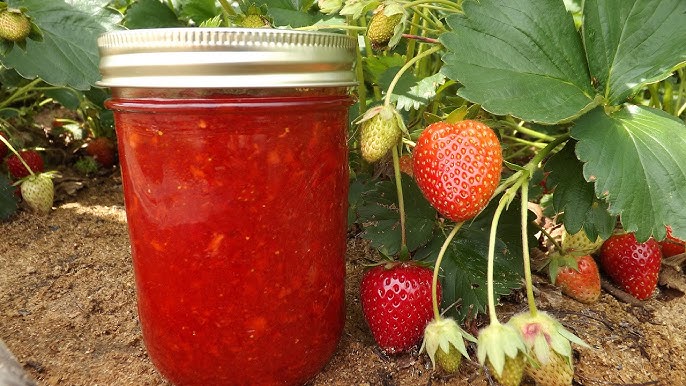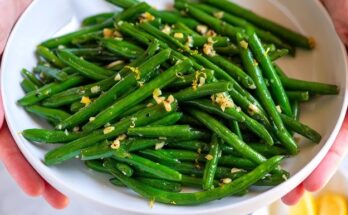Freezer Jam Recipe: Homemade freezer jam is one of those kitchen miracles that feels a bit like cheating—in the best way. It’s sweet, fruity, and full of that just-picked flavor, and the best part? No canning, no boiling jars, no complicated steps. If you’ve ever wanted to make your own jam without the traditional fuss, freezer jam is your answer.
This guide will walk you through exactly how to make freezer jam, including the ingredients you’ll need, tips to avoid common mistakes, and how to keep your jam fresh for months. Whether you’re a beginner or just looking to streamline your jam-making process, this step-by-step guide is for you.
What is Freezer Jam?
Freezer jam is a type of homemade jam that’s stored in the freezer instead of being preserved through the traditional canning process. It retains more of the fresh fruit flavor because the fruit isn’t cooked over high heat. Instead, it’s mixed with sugar and pectin, allowed to sit at room temperature to set, and then placed in the freezer.
What makes freezer jam special is its simplicity and the way it keeps the fruit tasting fresh, vibrant, and closer to its natural state. It also has a softer, more spoonable texture than traditional jam, making it perfect for toast, pancakes, yogurt, and even ice cream.
Why Make Freezer Jam Instead of Traditional Jam?
Let’s be real: traditional canning can be a bit intimidating. Between sterilizing jars, boiling water baths, and hoping for a proper seal, it’s not exactly a casual Sunday activity. Freezer jam skips all of that stress. There’s no need for a hot kitchen, complicated equipment, or hours of work.
Plus, since the fruit isn’t cooked down, you get a more intense, fruit-forward flavor. The color is brighter, the texture is fresher, and the whole process is much faster. If you’ve got 30 minutes and some ripe fruit, you can have jam ready to enjoy in no time.
Best Fruits for Freezer Jam
Not every fruit behaves the same when turned into jam, but luckily, there are a few rock stars that shine every time.
Strawberries
Strawberries are the classic freezer jam fruit. They’re sweet, juicy, and mash up perfectly.
Blueberries
Blueberries hold their shape more but still make a deliciously smooth and spreadable jam.
Peaches
Peaches give a slightly chunkier texture and add a tropical sweetness that’s irresistible.
Raspberries
Raspberries break down beautifully and bring a tangy twist that balances the sweetness perfectly.
You can even get creative with combos—think strawberry-peach, or blueberry-raspberry.
List of Ingredients You’ll Need
Here’s your simple shopping list for a basic freezer jam recipe:
- Fresh fruit (about 4 cups crushed)
- Granulated sugar (typically 1.5 to 4 cups, depending on the recipe and fruit)
- Pectin (either powdered or liquid; choose the type that matches your fruit and desired sweetness)
- Lemon juice (optional, but it helps preserve color and adds a bright flavor)
- Clean containers (plastic or glass jars with tight-fitting lids, freezer-safe)
That’s it. No weird preservatives or hard-to-pronounce chemicals—just real, simple ingredients.
Kitchen Tools and Supplies Required
You don’t need fancy gear, but a few essentials make the process easier:
- Mixing bowls (preferably large ones)
- Measuring cups and spoons
- A potato masher or food processor
- Whisk or spoon for stirring
- Funnel (helps avoid messy spills)
- Freezer-safe jars or containers
You probably already have most of this at home, which makes freezer jam even more appealing.
Choosing the Right Pectin for Freezer Jam
This part matters more than you might think. Pectin is the magic that helps your jam “gel” and set properly.
Regular Pectin
Traditional pectin requires full-sugar recipes to set. If you’re using standard pectin, follow the sugar amounts precisely—don’t reduce it, or your jam might end up runny.
Low-Sugar or No-Sugar Pectin
Perfect for those watching their sugar intake. These types of pectin let you cut back or substitute with alternatives like honey or stevia.
Pro tip: Always use the pectin brand’s instructions. Each brand (Sure-Jell, Ball, Pomona’s) has slightly different steps and ratios.
Step-by-Step Freezer Jam Recipe
Now, let’s get to the good part. Here’s how to make freezer jam from scratch:
1. Wash and Prep the Fruit
Clean your fruit thoroughly. Remove stems, pits, or peels if needed. Then crush the fruit. You can use a potato masher for a rustic texture or a food processor for smoother jam. Just don’t puree it into soup—you want small chunks for texture.
2. Measure Accurately
Use exact measurements for fruit, sugar, and pectin. Guessing can throw off the setting process, leaving you with jam that’s too runny or too thick.
3. Mix Fruit and Sugar
In a large bowl, combine your crushed fruit and sugar. Stir until the sugar is fully dissolved. Let it sit for about 10-15 minutes. This step helps draw out the juices and boosts flavor.
4. Prepare Pectin
While the fruit is resting, prepare your pectin according to the package instructions. Usually, this involves boiling water and pectin together until fully dissolved.
5. Combine and Stir
Pour the hot pectin into your fruit mixture and stir constantly for 2–3 minutes. You’ll feel the mixture thicken slightly—this is the magic happening.
6. Jar the Jam
Using a funnel, carefully pour the jam into clean containers, leaving about ½ inch at the top for expansion. Wipe the rims clean and seal tightly.
7. Let It Sit
Let the jars sit at room temperature for 12 to 24 hours to fully set. Don’t touch, move, or refrigerate them during this time.
8. Freeze It
After it sets, place the jars in the freezer. You can keep one or two in the fridge for immediate use, and freeze the rest for later.
Freezer Jam vs. Canned Jam – What’s the Difference?
So, what exactly sets freezer jam apart from the traditional canned version?
For starters, freezer jam skips the boiling process entirely. That means less prep time, fewer steps, and a much easier clean-up. Traditional jam is cooked down on the stovetop and then sealed in sterilized jars with a hot water bath—great for long-term pantry storage but more labor-intensive.
Freezer jam, on the other hand, maintains a fresh fruit taste and brighter color because it’s not exposed to high heat. This makes it taste more like the actual fruit and less like cooked sugar.
The texture is also different. Freezer jam is softer, more like a thick sauce than a gel, which makes it ideal for spooning over ice cream, swirling into yogurt, or spreading on toast without tearing the bread.
In short, if you’re looking for:
- Long shelf-life without a freezer? → Go canned.
- Fresh flavor and easy prep? → Stick with freezer jam.
How to Store Freezer Jam Properly
Proper storage is the key to keeping your jam safe and delicious.
Here’s how to do it:
- After setting, store containers in the freezer. They can last up to 12 months there.
- Once thawed, keep them in the refrigerator and use within 3–4 weeks.
- Always use airtight, freezer-safe containers. Glass or BPA-free plastic works best.
- Avoid overfilling the jars. Leave at least ½ inch of space at the top to allow the jam to expand as it freezes.
- Label each jar with the date and type of jam. You’ll thank yourself later.
If you’re using your jam frequently, you might want to divide it into smaller containers. That way, you can thaw one at a time and keep the rest frozen and fresh.
How Long Does Freezer Jam Last?
This is one of the biggest perks of freezer jam—it lasts a long time without any special preservatives.
- In the freezer: 12 months is the sweet spot. After that, the flavor and texture may start to degrade, even though it’s still technically safe to eat.
- In the fridge: Once thawed, it will last for about 3 to 4 weeks.
- If you notice any off smell, strange color, or mold, it’s time to toss it.
A helpful tip? Keep one jar in the fridge for everyday use, and leave the rest frozen. Rotate through your stash like a jam pro!
Tips for Making the Perfect Freezer Jam
Even though freezer jam is simple, a few little tricks can help you level up your jam game.
- Use fully ripe (but not overripe) fruit – underripe fruit lacks flavor, while overripe fruit can make the jam runny.
- Don’t reduce the sugar unless you’re using low- or no-sugar pectin.
- Mash, don’t puree – a bit of texture makes for a better eating experience.
- Stir, stir, stir – make sure the pectin is well distributed so the jam sets properly.
- Freeze in small batches – use 4 oz or 8 oz jars for easier storage and quicker thawing.
Following the instructions on your specific brand of pectin is non-negotiable. Different brands require different ratios and steps.
Common Mistakes and How to Avoid Them
Let’s save you some trouble and cover the mistakes most people make:
- Using too little sugar
Sugar isn’t just for sweetness—it helps the jam set. If you cut back too much without the right pectin, it won’t gel. - Skipping the wait time before freezing
You need to let the jam sit for 12–24 hours at room temp so it can set fully. - Over-pureeing the fruit
A smoothie might be great, but not for jam. Leave in some chunks. - Using metal lids that aren’t freezer-safe
Always use plastic lids or freezer-safe glass to avoid breakage and rust. - Overfilling the jars
Leave that headspace! The jam needs room to expand when it freezes.
How to Use Freezer Jam in Daily Life
This isn’t just for spreading on toast—freezer jam is surprisingly versatile.
Breakfast Ideas
- Swirl it into yogurt or oatmeal
- Spread it on pancakes, waffles, or English muffins
- Add it to smoothies for a natural sweetener
Dessert Toppings
- Spoon over ice cream, cheesecake, or pound cake
- Use as a filling in layer cakes or cupcakes
- Make easy fruit bars with a jam center
Creative Uses
- Stir into salad dressings for a fruity twist
- Glaze chicken or pork with a jam-based marinade
- Add to cocktails or mocktails for flavor and color
Troubleshooting: Why Isn’t My Jam Setting?
Sometimes, despite your best efforts, your jam stays a bit too runny. Here’s what might be going wrong:
- Too much fruit or too little sugar – Follow the exact measurements.
- Didn’t stir long enough after adding pectin – Make sure you mix for the full recommended time.
- Used old pectin – Pectin has a shelf life. Check those expiration dates.
- Fruit was too juicy or watery – Especially true with frozen fruits or extra-ripe produce.
Still runny? It’s not the end of the world. You can still use it as a topping or syrup!
Freezer Jam Without Sugar – Is It Possible?
Yes, but with caution.
You can make low-sugar or no-sugar freezer jam by using specially formulated pectin like Pomona’s Universal Pectin or Sure-Jell’s low-sugar version. These pectins are designed to gel without relying on sugar.
Instead of granulated sugar, try:
- Honey
- Stevia
- Agave nectar
- Monk fruit sweetener
Keep in mind: natural sweeteners may alter the flavor and setting time. Always check the instructions on your pectin package.
Making Freezer Jam with Frozen Fruit
No fresh fruit? No problem.
You can absolutely make freezer jam using frozen fruit. Just make sure to thaw and drain it before using to avoid excess liquid. Then follow the recipe as normal.
Pro tip: Frozen fruit is picked at peak ripeness, which makes it a great option when your favorite fruits are out of season.
Kid-Friendly Freezer Jam Recipes
Freezer jam is a perfect project for getting kids involved in the kitchen. Try these fun and fruity combos:
- Strawberry-Banana Jam
- Peach-Mango Jam
- Mixed Berry Jam with a hint of vanilla
Let them mash the fruit, stir in the sugar, or help label the jars. It’s fun, educational, and delicious.
You can even make jam popsicles by mixing a spoonful of jam into Greek yogurt and freezing in molds!
FAQs about Freezer Jam Recipe
1. Can I refreeze freezer jam after thawing?
It’s not recommended. Thaw only what you’ll use within a few weeks. Repeated freezing and thawing can affect texture and taste.
2. Is it okay to use metal lids for freezer jam?
Only if they’re labeled as freezer-safe. Otherwise, stick with plastic lids to prevent rusting and breakage.
3. Why does my freezer jam have crystals?
That’s sugar crystallization—usually from using too much sugar or not mixing thoroughly. Stir well and follow the recipe exactly.
4. Can I double the recipe?
Not recommended. Doubling can affect how the pectin sets. It’s better to make two separate batches.
5. What’s the best way to thaw freezer jam?
Place it in the refrigerator overnight. Never microwave it—that can mess with the texture.
Conclusion
Freezer jam is one of the easiest and most rewarding kitchen projects you can try. It doesn’t require fancy equipment or expert skills—just fresh fruit, a few simple ingredients, and a little bit of time. The results? Pure fruity bliss that you can enjoy all year long.
Whether you’re a seasoned cook or a total beginner, there’s something deeply satisfying about opening your freezer and seeing jars of vibrant, homemade jam just waiting to brighten your breakfast.
So grab that basket of berries or peaches and let’s get jamming—literally!



